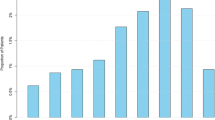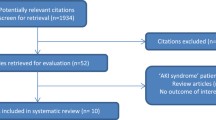Abstract
Objective: To assess the factors that affect the mortality in acute renal failure (ARF) in children. Patients and methods: We studied 149 patients with ARF and described the findings by age, gender, pathophysiological mechanism of renal damage, and type of renal damage, which can be oligoanuric and/or septic. We used multiple logistic analysis, Cox analysis for survival, and Kaplan–Meier curves. Results: The male/female ratio was 91/58. The most affected age groups were newborns (44.3%) and infants (37.6%). The ARF mechanism was ischemic in 87 cases (58%) and the most frequent clinical type was nonoliguric in 118 cases (79.2%). In the multiple logistic regression analysis, only oliguria (P=0.07) and age group (P=0.049) were associated with mortality. In the survival analysis using the Cox method, oliguria (P=0.003) and sepsis (P=0.03) were associated with mortality. The survival curves showed that the cumulative probability of dying in the first 10, 20, or 40 days after the event was 75, 70, and 45% respectively. When oliguria was present, the survival at day 10 was 47% and when sepsis was present it was 68%. Conclusion: Oliguria, age, and sepsis are factors associated with mortality in children with ARF.
Similar content being viewed by others
Avoid common mistakes on your manuscript.
Introduction
Acute renal failure (ARF) is a condition with increasing incidence in the pediatric, infant, and newborn population [1]. This is because of the increased possibility of preventing death in children exposed to severe and potentially fatal injuries, who will eventually develop ARF.
The epidemiological characteristics of this condition may be similar in developed countries. In low income countries, however, important differences must be taken into account relating to the level of poverty and access to, and the quality of, health services [2].
It is, nevertheless, still important to identify risks associated with major mortality, because this is the only way to achieve successful intervention in preventing death in children with established ARF [3, 4, 5, 6, 7, 8, 9, 10, 11].
The aim of this study was to analyze the risk factors for death in children with acute renal failure in a public general hospital in Metropolitan Lima (Cayetano Heredia Hospital). We describe our five years of experience in pediatric nephrology.
Patients and methods
In this study we included all children between 0 and 14 years old seen between July 1, 1996 and June 30, 2001 by the Nephrology Unit of the Hospital Nacional Cayetano Heredia (HNCH) with diagnosis of acute renal failure. This was defined as sudden loss of renal function and was identified by an increase in serum creatinine levels for the child’s age [12].
We collected the following data for each patient: age, gender, clinical presentation, type of renal failure (oliguric, nonoliguric), predominant physiopathological mechanism (ischemia, interstitial nephritis, urinary tract obstruction, nephrotoxicity, glomerular damage), final outcome, and associated diseases.
Oliguric ARF was defined as urine flow less than 1 cc kg−1 h−1, and pathophysiological mechanism was defined according to the main mechanism of injury. Sepsis was defined by the presence of bacteria isolated from the blood.
Data were analyzed with the statistical package SPSS V9, using nominal multiple regression analysis to evaluate variables related to death risk. Cox linear regression was used to evaluate the risks associated with mortality in ARF as a function of the variables that reached statistical significance (P<0.05). In the tables shown, the chi-square test or Fisher’s exact test for categorical variables was also used.
Results
In total, 149 children were identified as having acute renal failure. The male/female ratio was 1.58/1. There were 66 newborns (44.3%), 56 infants (37.6%), and 27 children of school age (18.1%).
The clinical presentation was nonoliguric in 118 patients (79.2%) and oliguric in 31 patients (20.8%). The main mechanisms of ARF were tubular necrosis in 79 patients (54.5%), acute interstitial nephritis in 44 patients (30.3%), glomerular disease in 16 patients (11.0%), and other causes in six patients (4.1%). Age group was associated with the clinical presentation (P=0.046) (Table 1) and type of damage (P=0.000) (Table 2). There was also an association between the type of damage and clinical presentation (P=0.001) (Table 3). In multinominal logistic regression analysis, only oliguria (P=0.07) and age group (P=0.049) were associated with mortality (Tables 4, 5, 6, 7). In the Cox model survival analysis, oliguria (P=0.003) and sepsis (P=0.03) influenced survival (Table 8).
Survival curves showed that the probability of dying in the first 10, 20, or 40 days after the event was 75, 70, and 45% respectively (Fig. 1). When oliguria was present, survival at 10 days was 47% (Fig. 2); when sepsis was present it was 68% (Fig. 3).
Discussion
In the literature from high-income countries cardiovascular surgery and uremic hemolytic syndrome are the most important risk factors associated with mortality in ARF in the pediatric population [13, 14, 15]. Arora et al. described a significant association between mortality in ARF and cardiovascular surgery and uremic hemolytic syndrome in 80 children less than 16 years old in India [3, 14].
After a study in New Zealand, on the other hand, Wong reported 27% mortality in children with ARF of etiologies other than uremic hemolytic syndrome and none in children with that disease [16].
The published results differ in clinical characteristics. This is clearly expressed in Hentschel’s review (1996) from Germany, in which he refers to mortality data in infants with acute renal failure varying from 25 to 78%, reporting, however, that renal disease by itself represents 0.9% of all deaths in children [1].
It is important to note that the results described in our population are not applicable to other populations. We can, however, describe coincidences in age group, where the vast majority show the high mortality associated with renal failure in newborns. A study group in Malaysia reports a mortality of 37.4% in very low weight newborns. Here a logistic regression analysis reports ARF as a risk factor for mortality [17]. Likewise, Hentschel reports premature birth as a risk factor for ARF [1]. However, Airede describes his experience of renal failure in newborns in Nigeria, finding a mortality of 51.2% in a four-year case series with an incidence of 3.9/1000 live births [18]. Moghal reports his experience of acute renal failure in children in the Children’s Hospital in Birmingham, UK; he found an incidence of 0.8 per 100,000 inhabitants, with hemolytic uremic syndrome the most common cause in 45% of cases. In the newborn group, ARF was related to surgery to correct congenital heart malformations in 63% and a global mortality rate of 25% [13, 14].
With regard to the type of clinical presentation in oliguric and nonoliguric ARF, we found that oliguric types had a worse outcome. This must be rapidly investigated, because this is seldom described in the literature as a prognostic factor in mortality related to ARF [19].
When we add sepsis, the situation becomes catastrophic and our series coincides with reports by Vega in a case series at Viña del Mar (Chile), in which he describes mortality in patients that developed ARF with sepsis (56 vs. 42.7%). Likewise Bhutta in Karachi (Pakistan) reports that sepsis in newborns was one of the major causes of morbidity and mortality among a cohort of 292 newborns; in a logistic regression model he found in the patients with sepsis and ARF an OR of 11.2 with death risk [8, 20].
In summary, we can confirm that for newborns with oliguria and sepsis the probability of dying is very high among our population, which agrees with most reports [7, 9, 10, 11, 21, 22]. We therefore recommend that physicians in charge of the treatment of a group with these characteristics should be alert to any manifestation that may predict the future of an infant patient with acute renal failure and mortality.
References
Hentschel R, Lodige B, Bulla M (1996). Renal insufficiency in the neonatal period. Clin Nephrol 46:54–58
Sakarcan A, Karabocuoglu M (1995). Renal replacement therapies for critically ill pediatric patients. Turk J Pediatr 37: 7–13
Arora P, Kher V, Rai KP, Singhai KM, Gulati S, Gupta A (1997). Prognosis of acute renal failure in children: a multivariate analysis. Pediatr Nephrol 11:153–155
Conlon PJ, Jefferies F, Krigman HR, Corey GR, Sexton DJ, Abramson MA (1998). Predictors of prognosis and risk of acute renal failure in bacterial endocarditis. Clin Nephrol 49:96–101
Wong W, McCall E, Anderson B, Segedin E, Morris M (1996). Acute renal failure in the paediatric intensive care unit. NZ Med J 109:459–461
Conlon PJ, Procop GW, Fowler V, Eloubeidi MA, Smith SR, Sexton DJ (1996). Predictors of prognosis and risk of acute renal failure in patients with Rocky Mountain spotted fever. Am J Med 101:621–626
Smoyer WE, McAdams C, Kaplan BS, Sherbotie JR (1995). Determinants of survival in pediatric continuous hemofiltration. J Am Soc Nephrol 6:1401–1409
Airede A, Bello M, Weerasinghe HD (1997). Acute renal failure in the newborn: incidence and outcome. J Paediatr Child Health 33:246–249
Verlato G, Fanos V, Tato L, De Marco R (1997) Mortality from renal causes of death in an Italian population under 20 years of age in the 1979–1991 period. Pediatr Med Chir 19:365–368
Flores NG, Joachin RH, Lopez PMG, Corzo PJA, Ramirez GLA (1998). Perinatal risk factors for mortality in the high-risk newborn. Gynecol Obstet Med 66:440–443
Lombardi R, Zampedri L, Rodriguez I, Alegre S, Ursu M, Di Fabio M (1998).Prognosis in acute renal failure of septic origin: a multivariate analysis. Ren Fail 20:725–732
Kanwal KK (1992), Evaluation of renal functions. In: Manual of pediatric nephrology, chap 1, pp 2–22
Spizzirri FD, Rahman RC, Bibiloni N, Ruscasso JD, Amoreo OR (1997).Childhood hemolytic uremic syndrome in Argentina: long term follow-up and prognostic features. Pediatr Nephrol 11:156–160
Florentín de Merech L (2001). Prevalencia de insuficiencia renal aguda y de sus etiologías más frecuentes en pacientes nefrológicos pediátricos. Arch Argent Pediatr 99:219–227
Jmelnitsky LB, Sasbon J, Weller G (1995). Insuficiencia renal aguda en el postoperatorio cardiovascular inmediato con circulación extracorpórea. Arch Argent Pediatr 93:372–375
Liano F, Pascual J (1996). Epidemiology of acute renal failure: a prospective multicenter, community-based study. Madrid Acute Renal Failure Study Group. Kidney Int 1996 50:811–818
Jensen MB, Ejlersen E, Eliasen KR, Lokkegaard H (1995). Prognosis for patients admitted to intensive care units with acute renal failure requiring dialysis. Ugeskr Laeger 1 157:2564–2569
A national study of risk factors associated with mortality in very low birth weight study group. J Paediatr Child Health (1997) 33:18–25
Flynn JT (1998). Causes, management approaches, and outcome of acute renal failure in children. Curr Opin Pediatr 10:184–189
Vega J, Borja H, Videla C, Aldunate T, Clavero R, Echevarria C, Torres H, Varela C, Vilches G, Diaz R (1996). Acute kidney failure in patients with and without sepsis: prognosis and clinical course. Rev Med Chil 124:938–946
Rivera-Moreno MA, Mercado-Arellano JA, Ulloa-Ricardez A, Franco-Gutierrez M (1999). Risk factors related to mortality in newborns with stage III necrosing enterocolitis. Gac Med Mex 135:245–251
Fiaccadori E, Lombardi M, Leonardi S, Rotelli CF, Tortorella G, Borghetti A (1999). Prevalence and clinical outcome associated with preexisting malnutrition in acute renal failure: a prospective cohort study. J Am Soc Nephrol 10:581–593
Acknowledgment
We thank the University Support Laboratory at the Nephrology Unit, Universidad Peruana Cayetano Heredia.
Author information
Authors and Affiliations
Corresponding authors
Rights and permissions
About this article
Cite this article
Loza, R., Estremadoyro, L., Loza, C. et al. Factors associated with mortality in acute renal failure (ARF) in children. Pediatr Nephrol 21, 106–109 (2006). https://doi.org/10.1007/s00467-005-2038-y
Received:
Revised:
Accepted:
Published:
Issue Date:
DOI: https://doi.org/10.1007/s00467-005-2038-y







